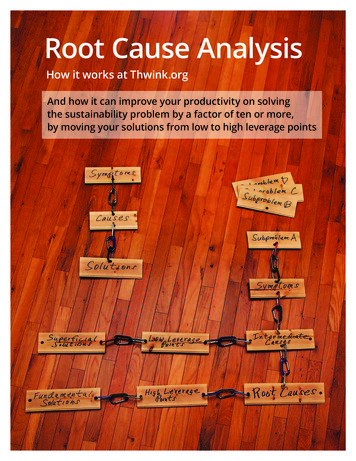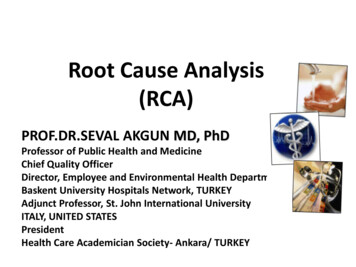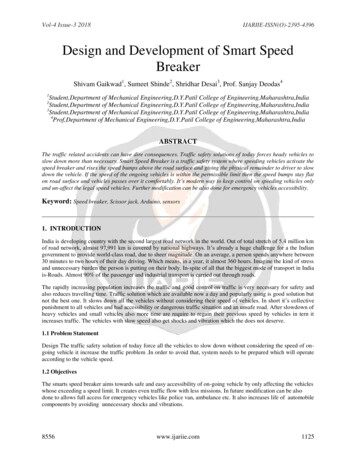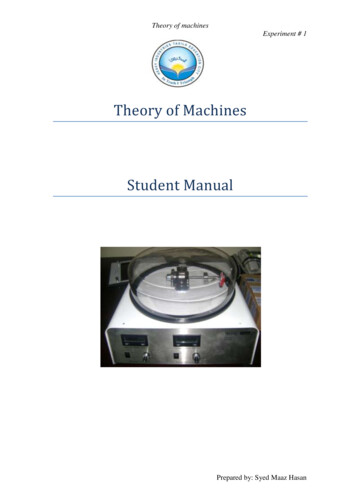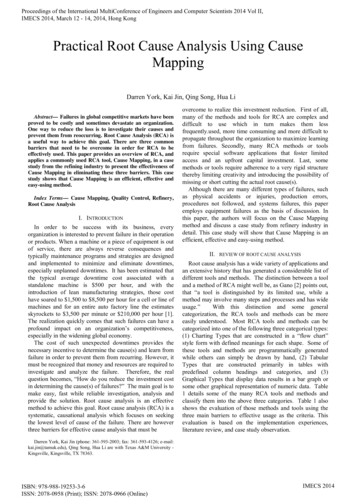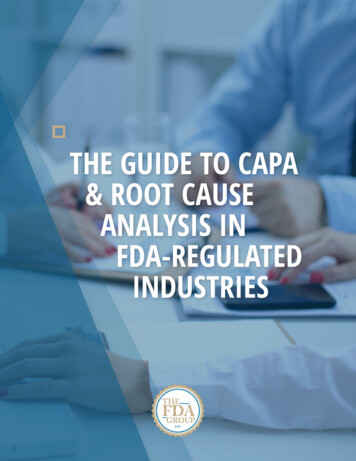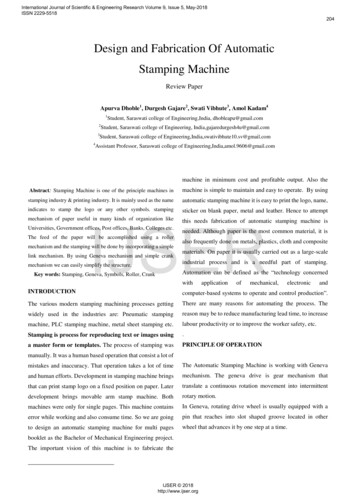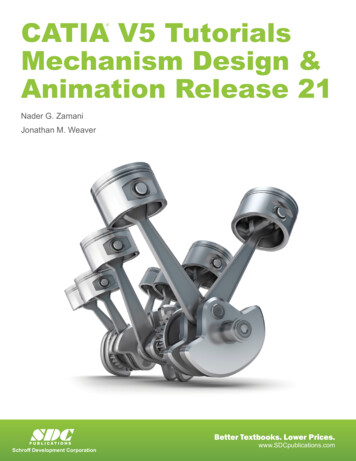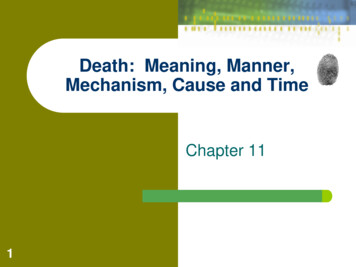
Transcription
Death: Meaning, Manner,Mechanism, Cause and TimeChapter 111
Introduction: Death is a process rather than an instantevent:1)First stage – stoppage 2)Second stage – autolysis 2Nerves, muscles, organs, brain stop due to lack ofoxygen to cells.Cell breaks downCell membrane dissolves and enzymes and other cellcontents spill out and digest surrounding tissues.Forensic Science: Fundamentals & Investigations, Chapter 11
hetrade.htmlDiscoveryhealth.com“Dr G tools of trade”Introduction: Forensic Pathologist:–––Medical doctorCases of suspicious or unnatural deathsConducts autopsy to determine: 3Manner of deathCause of deathMechanism of deathForensic Science: Fundamentals & Investigations, Chapter 11
The Manner of Death According to the death certificate, there are 4 waysa person can die, called the manner of death:1)Natural:–Interruption or failure of body functions–Most common manner of death.2)Accidental death: unplanned eventsEx: car accident or fall from ladder
3) Suicidal Death: Person takes own life Ex: drug overdose 4)Homicidal Death: death caused byanother person4 ) Undetermined Death: –Sometimes difficult to determine Ex. Did a person take an overdose or werethey given an overdose?
Cause of Death The reason for the death is the cause ofthe death.– Ex: disease, stroke, injuryEx: shooting, drowning, strangulation
Mechanism of Death: The specific change in the body thatbrought about the cessation of life is themechanism of death.Ex: if shot mechanism may be blood loss
Time of Death: When did a person die?–Why do we need to know this? 8Can prove a suspect innocent, link a suspect to a victim,etc .Many factors are used to determine the timeof death.Forensic Science: Fundamentals & Investigations, Chapter 11
Time of DeathLivor MortisLivor Mortis means death color. As a body decomposes: the red blood cells break down, contents spill out, andturn a bluish-purple.blood seeps down and settles (pools) in the lower partsof a body:––9Called lividity.Purplish-blue discoloration on the skin–Begins 2 hours after death (if skin is pressed down, colordisappears)–Permanent after 8 hours (if skin is pressed down, colorremains)Forensic Science: Fundamentals & Investigations, Chapter 11
Time of DeathLivor Mortis cont The ambient temperature at which a persondies impacts the time it takes for lividity to setin:–– Extent of livor mortis can be affected byanything impeding the flow of blood.–10Heat increases the rate of livor mortis.Very important to record environmentalconditions surrounding a dead body.Ex: wristwatch, belt, etc .Forensic Science: Fundamentals & Investigations, Chapter 11
Time of DeathLivor Mortis cont Liver mortis can provide other important clues. Becausegravity pulls blood down, lividity can–reveal the position of the body during first 8 hours. Ex: Blood pooled in lower arm and hands, lower legsand feet:––Corpse wedged into standing position.reveal if a body has been moved. Ex: Dual lividity–11Face, chest, abdomen, front surface of legs– Back of thighs, buttocks, and bottom of feet.Moved from lying face down to sitting in chair or viceversa during hours 2 to 8. Not uncommon in murders.Forensic Science: Fundamentals & Investigations, Chapter 11
Time of DeathRigor MortisRigor mortis means death stiffness. At death, skeletal muscles cannot relax.Without oxygen, calcium accumulates in these muscles.The muscles become stiff within 2 hours after death.This starts in the head and works its way down to the legs.At 12 hours after death, the body is at its most rigid state.After about 15 hours, the muscle fibers begin to dissolve,and softening begins (head first then downward).– 12Time varies based on environmental conditions.This stiffness will have disappeared for the most part after 36hours (48 hours max).Forensic Science: Fundamentals & Investigations, Chapter 11
Time of DeathRigor Mortis cont Many factors affect when rigor mortis sets in and how long itlasts. When trying to estimate time of death, these need tobe taken into account:1)Ambient temperature 2)The weight of the body 3)Body fat slows down the onset of rigor since it stores oxygen.The body’s clothing or lack of it 13Cooler the body, the slower the onset of rigor.More clothes faster onset of rigor (keeps body warmer)Forensic Science: Fundamentals & Investigations, Chapter 11
Time of Death—Rigor Mortis cont Factors cont 4) Any illness the person had at the time of death Hypothermia slower onset of rigor Fever faster onset of rigor5) The level of physical activity at the time of death Exercising or struggling faster onset of rigor––Increased body tempDecreased cell oxygen Sleep slows rigor (more oxygen in cells)6) Sun exposure Warmer body faster onset of rigorBecause of all of these factors, a precise time of deathcannot be determined, it can only be estimated.
Time of Death—Rigor Mortis If a body has no visible signs of rigor, itprobably has been dead:– less than 2 hoursOR– more than 48. If the body exhibits rigor only in the head andneck:– the time of death is just over 2 hours.15Forensic Science: Fundamentals & Investigations, Chapter 11
Time of Death—Algor MortisAlgor Mortis means death heat. It describes thetemperature loss in a corpse. In death a body no longer generates warmth and begins tocool down. To find the standard temperature of a corpse, athermometer is inserted into the liver. Body heat is lost:– 0 hrs to 12 hours, body cools at a rate of about 1.4 degrees Fper hour (0.78 degrees C/hour).– 12 hours till body reaches surrounding temperature, bodycools about 0.7 degrees F per hour (0.39 degrees C/hour).16Forensic Science: Fundamentals & Investigations, Chapter 11
Algor Mortis Example 11) Approximately howlong has a victim beendead if his bodytemperature is 35.6degrees C?17Forensic Science: Fundamentals & Investigations, Chapter 11- Know:normal 37 Cnow 35.6 C0 – 12 hours loss of 0.78 C–Solution:Find temp difference:37 – 35.6 1.4 CLess than 12 hours so:0.78 x 1.4x 1.79 hours
Algor Mortis Example 21)Approximately how longhas a victim been dead ifher body temperature is22.9 degrees C?- Know:normal 37 Cnow 22.9 C0 – 12 hours loss of 0.78 Cover 12 hours loss of 0.39 C18Forensic Science: Fundamentals & Investigations, Chapter 11Solution:Find temp difference:37 – 22.9 14.1 CDuring 0 - 12 hours:12 x 0.78 9.36 C lostFrom 12 hours and up:14.1 – 9.36 4.74 CAdditional hours:0.39 x 4.74x 12.15 hoursTotal hours:12 12.15 24.15 hours sincedeath
Time of Death:Algor MortisAlgor Mortis cont Rates vary with surrounding temperature andconditions:– Temp Cooler environment faster heat loss Windy faster heat loss Body fat slower heat loss Clothing slower heat loss Time of death determined by temperaturecalculations is expressed as a range of time sinceit cannot be calculated exactly.19Forensic Science: Fundamentals & Investigations, Chapter 11
Stomach andIntestinal ContentsMedical examiners help determine time of death bystudying the corpses stomach contents: It takes about 4 to 6 hours for the stomach to emptycontents into small intestine. Another 12 hours for the food to leave the smallintestine. Total of 24 hours from when meal was eaten until allundigested food is released from the large intestine.20Forensic Science: Fundamentals & Investigations, Chapter 11
Stomach andIntestinal ContentsBased on these specifics, give an estimate for each of these onhow much time has passed since the meal was eaten:1. Undigested food is still present in the stomach. 2.The stomach is empty but food is found in the small intestine. 3.Death occurred at least 4 to 6 hours after a meal.The small intestine is empty but waste is present in the largeintestine. 21Death occurred 0 to 2 hours after last mealDeath occurred 12 or more hours after a meal.Forensic Science: Fundamentals & Investigations, Chapter 11
Changes of the EyeFollowing Death: In life, eye is kept moist by blinking.Following death:––Eye dries out.Thin film is observed: 222 to 3 hours if eyes open at time of death.Within 24 hours if eyes were covered at time of death.Forensic Science: Fundamentals & Investigations, Chapter 11
Stages ofDecomposition:Decomposition means rotting.1) Within 2 Days of Death:a)b)c)d)23Cell autolysis begins following death.Green and purplish staining occurs from blooddecomposition.Skin takes on a marbled appearance.Face becomes discolored.Forensic Science: Fundamentals & Investigations, Chapter 11
Stages ofDecomposition:2) Within 4 Days of Death:a)b)Skin blistersAbdomen swells with the gas carbon dioxide-released from bacteria living in intestines3) Within 6 to 10 Days of Death:a)b)c)d)24Corpse bloats causes chest and abdominal cavities burstand collapseFluids begin to leak from body openings as cellmembranes rupture.Eyeballs and other tissues liquefySkin sloughs offForensic Science: Fundamentals & Investigations, Chapter 11
Stages of Decomposition:More information: Initial Decay: Putrefaction: Odor of decaying flesh is presentCorpse appears swollen.Black Putrefaction: 25Corpse appears normal on outsideStarting to decompose on inside due to bacteria and autolysis Very strong odorParts of flesh appear blackGases escapeCorpse collapsesForensic Science: Fundamentals & Investigations, Chapter 11
Stages ofDecomposition:More information cont Butyric Fermentation: Dry Decay: 26Corpse begins to dry outMost of flesh is goneCorpse is almost dryFurther decay is very slow from lack of moistureForensic Science: Fundamentals & Investigations, Chapter 11
Decomposition:Speed of decomposition depends on: Age– – Heavier decay faster–Clothing––Sick decay fasterClothed decay slower –Forensic Science: Fundamentals & Investigations, Chapter 11More moisture meansfaster decayDry air dries out andpreserves bodiesLocation of body:–27Higher temps decayfasterHumidityHealth– TemperatureYoung decay fasterSize of body– Decay most quickly in airDecay slower in water orburied
InsectsForensic Entomology is the study of insects as theypertain to legal issues. A forensic entomologist:– Records data about environmental conditions around thebody as well as below it: Temperature Moisture wind– collects insect evidence. On body Above and below body Immediate area around victim28Forensic Science: Fundamentals & Investigations, Chapter 11
Insects:29Forensic Science: Fundamentals & Investigations, Chapter 11
Insects Within minutes of a death, certain insects arrive to laytheir eggs on the warm body.– Blowflies are a common example.– Attracted to two gases of decomposition: Putrescine Cadaverene30Forensic Science: Fundamentals & Investigations, Chapter 11
Insects As a corpse progresses through the stages ofdecomposition, other kinds of insects arrive.– Tiny wasps lay eggs on maggots already on body– Cheese skippers arrive with seepage of bodyfluids– Last to arrive are mites and beetles: feed on dry tissues and hair.31Forensic Science: Fundamentals & Investigations, Chapter 11
Blowflies:First to arrive on body. Very useful in determiningtime of death since forensic scientists know howlong it takes for the various stages at giventemperatures Exhibit different stages as they develop––––32EggLarva also known as instars (maggot)PupaAdultForensic Science: Fundamentals & Investigations, Chapter 11
33Forensic Science: Fundamentals & Investigations, Chapter 11
Blowflies: Easy to identify stage based on:––––34Change in sizeColorMobilityNumber of spiracle slitsForensic Science: Fundamentals & Investigations, Chapter 11
Blowflies:1. Egg:a. 2 mm longb. Whitec. Appears soon after deathd. Phase lasts 8 hourse. Found moist warm areas of body:a. Mouth, eyes, anus, ears35Forensic Science: Fundamentals & Investigations, Chapter 11
Blowflies:2) Larva 1st Instar:a. 5 mm in lengthb. Whitec. Appears 1.8 days after deathd. Stage lasts 20 hourse. One spiracle slit near anusLarva is a maggot36Forensic Science: Fundamentals & Investigations, Chapter 11
Blowflies:3) Larva 2nd Instar:a.b.c.d.e.3710 mm in lengthWhiteAppears 2.5 days after deathStage lasts 15-20 hoursTwo spiracle slits near anusForensic Science: Fundamentals & Investigations, Chapter 11
Blowflies:4) Larva 3rd Instar:a.b.c.d.e.3817 mm in lengthWhiteAppears 4-5 days after deathStage lasts 36-56 hoursThree spiracle slits near anusForensic Science: Fundamentals & Investigations, Chapter 11
Blowflies:5) Pupa:a.b.c.d.e.f.g.399 mm in length (football shaped)BrownLarva migrates away from body to a dry areaAppears 18 -24 days after deathStage lasts 6 -12 daysImmobileDoes not feedForensic Science: Fundamentals & Investigations, Chapter 11
Blowflies:6) Adult Flya.b.c.d.e.40Length variesGreen or blackAppears 21-24 days after deathLives several weeksCannot fly first few hoursForensic Science: Fundamentals & Investigations, Chapter 11
Blowfly examples:If corpse contains blowfly eggs then approximatetime of death is:1)-2)Less than 1.8 days agoIf corpse contains 2nd instar larvae thenapproximate time of death is:- 2.5 to 3.5 days ago3)If corpse contains pupa then approximate time ofdeath is:- 18 to 24 days ago41Forensic Science: Fundamentals & Investigations, Chapter 11
Time of Death—Insects Life cycles are affected by fluctuations in thedaily environmental conditions:– temperature- moisture-wind– time of day- season-exposure to elements insect evidence cannot provide an exacttime of death but can yield a close estimate.42Forensic Science: Fundamentals & Investigations, Chapter 11
2 Forensic Science: Fundamentals & Investigations, Chapter 11 Introduction: Death is a process rather than an instant event: 1) First stage - stoppage Nerves, muscles, organs, brain stop due to lack of oxygen to cells. 2) Second stage - autolysis Cell breaks down Cell membrane dissolves and enzymes and other cell contents spill out and digest surrounding tissues.


